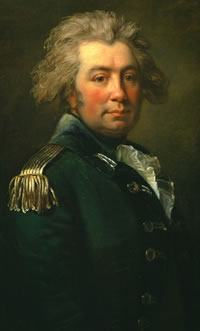King's Bounty: the land-granting process
Note: this section is still in development.
Background
Land grants permitted the grant recipient to settle and develop his parcel of land. However, only after the grantee fulfilled certain requirements — usually clearing a certain portion of the land, and perhaps also building a house within a certain period (a year or set number of years) — was the grantee entitled to patent the land. A patent transferred full ownership of the land from the Crown to the new owner, in "fee simple", that is, with the right to hold, lease, sell, and transfer ownership after death through inheritance.

King George III
King George:
the Proclamation of 1763
The first rules around the land granting process were set in 1763, soon after the Treaty of Paris ended the Seven Years' War between England and France. That war, known in North America as the French and Indian War, resulted in France ceding to Britain its vast North American territory (as well as several Caribbean islands).
King George III issued a proclamation that that all officers and soldiers who had served in the American war, and had settled in Quebec (then Canada) were to be rewarded with grants of land, without fee, in the following quantities:
To every Person having the Rank of a Field Officer, 5,000 Acres.
To every Captain, 3,000 Acres.
To every Subaltern or Staff Officer 2,000 Acres.
To every Non-Commissioned Officer 200 Acres.
To every Private Man 50 Acres.
The Simcoe Proclamation of 1792
The new province of Upper Canada was created in 1791. The following year the new Lieutenant-Governor, John Graves Simcoe, expanded the rules around the land-granting process with a proclamation on February 7, 1792, offering free land to anyone of good character who was willing to swear and sign an oath of loyalty to the English king.
Farms were to be granted in 200-acre lots, but grants up to an additional 1000 acres could be made at the discretion of the Executive Council. The only cost would be the various clerks' fees for processing the grant, which would be kept at low level by a published fee list.
Simcoe sent a copy of his proclamation to the British consul-general in Philadelphia, resulting in a rush of "late Loyalists" — Americans, many of whom had actually fought on the American side during the War of Independence, who were now willing to swear loyalty to England in exchange for the free land.
Many, but not all, were faithful to that oath during the American invasion of Upper Canada in the War of 1812.
More information to come.
The TORONTO PARK LOT PROJECT — an exploration of the earliest days of the TOWN OF YORK, founded in 1793 by John Graves Simcoe, first Lieutenant-Governor of Upper Canada.
